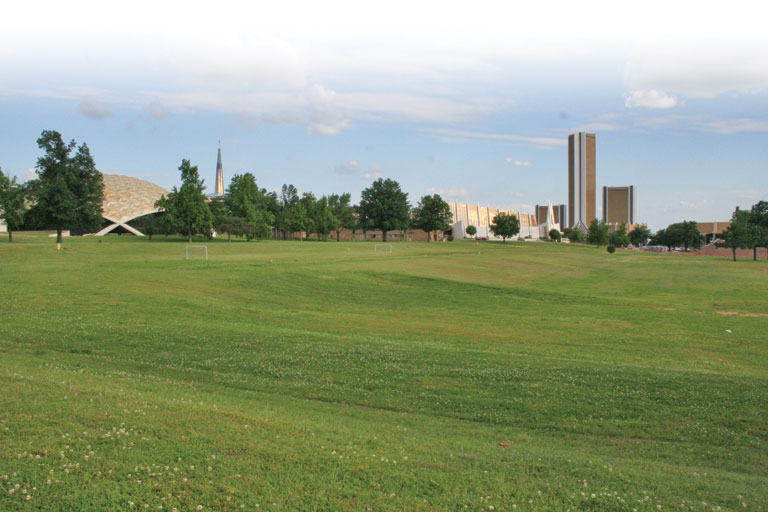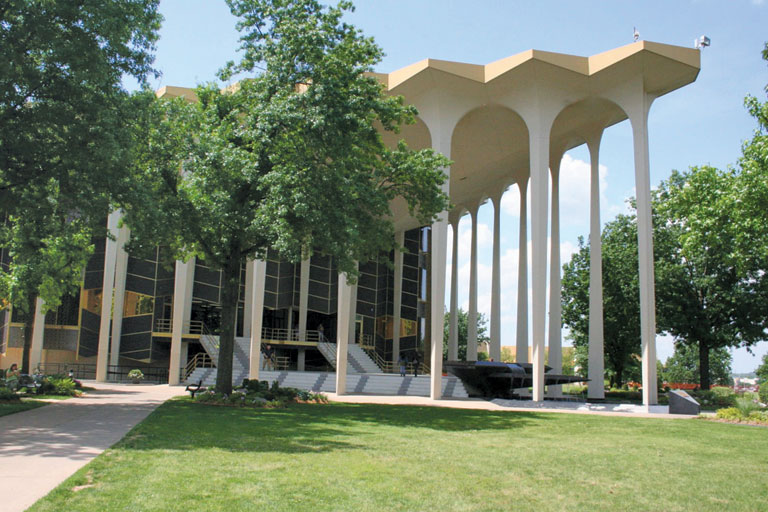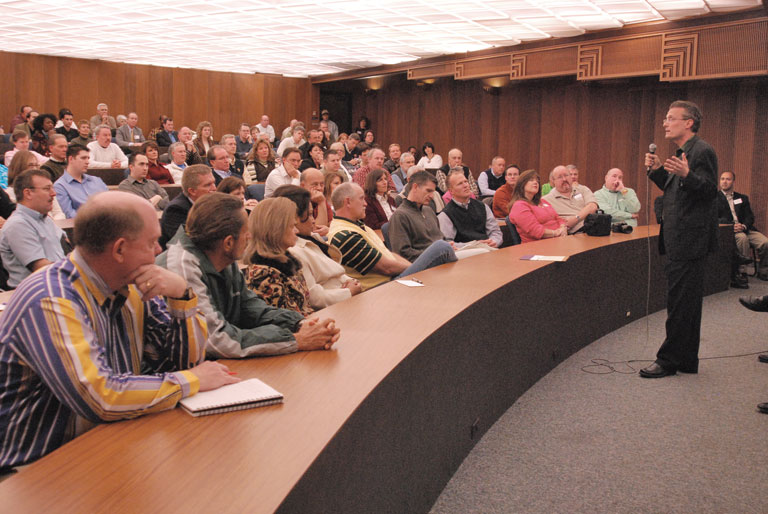 |
| Oral Roberts |
In May, In Trust president Christa Klein and editor Jay Blossom visited Oral Roberts University (ORU) and spoke to board chair Mart Green, interim president Ralph Fagin, board member Glenda Payas, and several faculty and administrators. Our goal: To learn how generous philanthropy, coupled with a renewal of governance practices, brought about institutional change at ORU.
Two years ago, facing crippling debt, legal allegations against members of its founding family, demoralized faculty, and declining enrollment, the university was given an unprecedented opportunity when a donor stepped in with a generous offer - an $8 million outright gift and a promise of $62 million more if ORU was willing to build a new board, make its finances transparent, and institute best practices in governance.
The renewal of ORU is not just an example of what a large gift can do to save a school. Rather, ORU's turnaround shows how a major gift can become the catalyst for institutional change. At ORU, when the reinvigoration of shared governance became a precondition for a philanthropic gift, that gift became a catalyst for a deep-seated transformation of the institution, rather than a one-time, and perhaps ephemeral, rescue.
This is the first installment in a multipart series.
Oral Roberts University is not a typical institution of higher learning.
To be sure, no college or theological school is "typical," but ORU has a particularly unusual history. It was founded in 1963 by a charismatic television evangelist who believed God had quite literally told him to "build Me a university and build it on My authority and the Holy Spirit." After the first students were admitted in 1965, the university grew rapidly, buoyed by the popularity of Oral Roberts himself. A visionary who had left his Pentecostal Holiness background to become a charismatic United Methodist, Roberts preached to huge television audiences - 25 million saw his Christmas special in 1971. [Oral Roberts died December 15, 2009. Read an obituary here. See a slide show of images from his early ministry here.]
Roberts always dreamed big. He envisioned a comprehensive university, so programs in law, dentistry, medicine, nursing, business, education, engineering, and theology were eventually established, in addition to the humanities and liberal arts. The Higher Learning Commission of the North Central Association of Colleges and Schools accredited the university in 1971; accreditation from the Association of Theological Schools (ATS) followed in 1980. ORU's School of Theology and Missions, like 35 percent of all ATS-accredited institutions, is considered an "embedded" theological school because it is a graduate school within a university. With a head count of 452 students in fall 2008 (and a full-time equivalent of 267), it's one of the larger North American theological schools.
By the time that Roberts dedicated the 648-foot skyscraper of the City of Faith Medical Center in 1981, the 263-acre ORU campus on the southern edge of Tulsa, Oklahoma, already featured an impressive collection of futurist-themed buildings, most designed by Tulsa architect Frank Wallace. They included an 11,000-seat arena, a 3,500-seat chapel, eight dorms, and a 900,000-square-foot academic building and library. ORU's signature building had been dedicated in 1967 - the 200-foot-tall Prayer Tower. For many years, telephone operators in tiny offices at the tower's top took calls and prayed for viewers around the clock.
 |
| The 60-story CityPlex Tower (formerly the City of Faith Medical Center) overlooks ORU's campus. |
Oral Roberts served as first president of the university before retiring in 1993 and being named chancellor. His son Richard inherited the role and also took over as head of the Oral Roberts Evangelistic Association, which was legally part and parcel of the university. Governance was vested in a board of regents, all of whom were committed supporters of the evangelistic ministry, its founder, and his son.
The de facto power within the board of regents were the "lifetime spiritual regents," who in 2007 included Oral Roberts, Richard Roberts, and his wife, Lindsay Roberts. (Lifetime regent Evelyn Roberts, Oral's wife of 66 years, had died in 2005.) Lindsay Roberts also served as executive vice president of the Oral Roberts Evangelistic Association.
Governance problems surface
Two years ago, Oral Roberts University was suddenly in the national news. On October 2, 2007, three former faculty members filed suit in Tulsa County District Court alleging wrongful termination, breach of contract, and defamation. The suit detailed a laundry list of allegations against Richard and Lindsay Roberts - for example, that the Roberts family frequently charged personal expenses to the university and that there had been inappropriate personal contact between Lindsay Roberts and male students. Furthermore, the suit accused Richard Roberts of directing one of the plaintiffs to organize students in behalf of a candidate for mayor of Tulsa, which had resulted in an IRS investigation in 2006. Finally, the suit charged that this list of misdeeds had been presented to the regents earlier in 2007, and as a result, two of the plaintiffs had been dismissed.
Richard Roberts took a leave of absence from the university on October 17 while denying the allegations in the suit. On November 23, he resigned from the university, while remaining a lifetime spiritual regent and retaining his role as head of the evangelistic association.
ORU's problems may have come into public view suddenly, but governance problems had percolated under the surface for years. As far back as the 1980s and 1990s, the Internal Revenue Service and the regional accrediting body had warned about irregular finances, an insufficiently independent board, and erratic leadership. A campus visit by the Higher Learning Commission in November 2007 - the same month that Richard Roberts resigned - reiterated the same deficiencies.
Shaken by the accreditation visit and the lawsuit, the regents took stock of their situation: ORU's "brand" was damaged - perhaps irreparably. The university was $55 million in debt. Additional tens of millions of dollars were needed to repair and update the university's aging jet-age modernist buildings. Student enrollment had been declining for years. And the university had no leader.
An unforeseen opportunity with significant preconditions
Down in Oklahoma City, a 66-year-old businessman named David Green had been following the troubles at Oral Roberts University in the newspaper. Founder and owner of the Hobby Lobby chain of 432 arts and crafts stores, Green had encountered ORU graduates and had been impressed by them, but he had no formal contacts with the university. A largely under-the-radar donor to various religious organizations, he had never given ORU even a dollar. Nevertheless, he felt called to do something to keep the school afloat. And at No. 281 on the "Forbes 400" list of richest Americans, with a net worth estimated by Forbes at $1.7 billion, he was in a position to do something.
David Green talked to his son, Mart, about his idea. And four days after Richard Roberts resigned from the presidency, 46-year-old Mart Green was in Tulsa at the meeting of ORU's board of regents. The Greens' proposal was a generous offer with a big string attached. He told them that the family would donate $8 million to ORU and was prepared to offer up to $62 million more, which would reduce the university's debt and help address its deferred maintenance. But in return, they would have to make sweeping changes in leadership and in financial accountability. After meeting with the regents, Green told the assembled press that the gift was conditional on the school instituting standards of "21st-century governance," a phrase his publicist had suggested.
Then Green himself went to school to learn more about governance. When he asked friends and colleagues who could advise him, the name he kept hearing was Robert E. Cooley, president emeritus of Gordon-Conwell Theological Seminary in South Hamilton, Massachusetts. The son of an Assemblies of God minister, Cooley had deep experience in the Pentecostal tradition. As a past president of ATS and the former board chair of In Trust, he was also a sought-after expert on theological school governance and board development. (He serves as one of In Trust's Governance Mentors.)
 |
|
The Learning Resources Center/Graduate Center at Oral Roberts University is a 900,000-square-foot building that includes classrooms, administrative offices, and the university library.
|
Green flew to Charlotte on December 4, 2007, with some advisers in tow - including a corporate attorney, an expert in finance, a public relations officer, and his brother. During a two-day meeting, Cooley introduced the concept of shared governance to Green and his team.
Over the following three weeks, Cooley and Green's team hammered out a proposal, and by early January, they were ready. As delivered to the board of regents, the proposal laid out a frank analysis of the strengths and problems at ORU and delineated a prescription for change.
It acknowledged, after discussions with Higher Learning Commission officials, that the university's academic programs, students, and faculty were of high caliber. But it charged that "systematic failure of proper governance over many years has diminished greatly the trust and respect of the students, alumni, faculty, and stakeholders in the University and placed the University at financial risk." The certificate of incorporation and the bylaws "fail[ed] to provide acceptable standards of institutional authority and governance," were "obsolete," and would have to be revised.
Green's proposal demanded other significant changes as well:
■ Separation. The Oral Roberts Evangelistic Association and the university would have to become completely separate entities.
■ New governing board. The board of regents would cease to exist, to be replaced by a new board of trustees with nine to 22 members. The new trustees would focus on four responsibilities: safeguarding the university's mission, supporting and directing the president, providing adequate resources for the university, and "establishing policies and planning through the processes of shared governance."
■ New advisory board. Former regents would be invited to join a new "board of reference," which would have a purely advisory role.
■ Financial integrity. The university would seek full membership in the Evangelical Council for Financial Accountability, a 30-year-old organization with strict requirements to ensure that member organizations operate with financial transparency.
■ Proposed slate of new trustees. Before dissolving, the board of regents would elect a slate of 13 members (proposed by the Greens) for the new board of trustees, including Mart Green a s chair and Oral Roberts as the only life member.
■ Regents permitted to select some new trustees. The outgoing business regents would also nominate six of their own to serve on the new board, and the Greens would select at least three of these six to serve.
■ Control over major gift. The new board would have sole control of the $62 million donation from the Green family.
On January 14, 2008, Robert Cooley joined Mart Green, his father, David, their attorney, and their accountant in Tulsa to meet with ORU's full board of regents. After the Greens presented the proposal, Cooley spoke about shared governance and answered questions. Robert Landrebe, the chief financial officer of Gordon-Conwell Theological Seminary, who also serves as one of In Trust's Governance Mentors, presented a realistic assessment of the university's financial picture.
And then the Greens, Cooley, and Landrebe left the room. The regents were left to make the biggest decision in the history of Oral Roberts University. The Greens were prepared to walk away if the regents refused their terms.
Now, the hard part
The regents voted to accept the proposal. At the end of the day, Mart Green announced, "We stand together today knowing that the future of ORU is strong. Our proposal focuses on a new shared governance model that will carry forward this university's mission and founding vision for generations to come." Thanks to Cooley's coaching, he had a pretty good idea of what this "new shared governance model" might look like - a president who would be responsible to an independent board of trustees, together with an appropriate role for faculty in the academic decision-making process.
The rest of the month was a whirlwind.
The following day, the regents created a temporary board to aid the transition to the new board of trustees, and Green announced that Ralph Fagin, executive vice president for academic affairs, would serve as interim president. Fagin was the natural choice, Green said, because during the search for a permanent president, he was looking for an insider who was respected by the faculty but who did not wish to be considered for the permanent post.
On January 29, the university filed an "amended and restated certificate of incorporation" with the Oklahoma secretary of state, which legalized the new board of trustees as the decision-making body for the university. It also stipulated that Oral Roberts University cannot change its legal name except by a vote of 100 percent of the whole board of trustees at three consecutive annual meetings.
On January 30, the board adopted new bylaws, which are available online at www.oru.edu/the_new_oru/board_of_trustees/pdfdocs/bylaws.pdf. Among the details about the board's membership, duties, and committees, is this reminder: "The President [of the university] serves at the pleasure of the Board of Trustees for such term, compensation, and conditions of employment, as the Board shall determine. . . . His or her authority is vested through the Board of Trustees." The bylaws also enumerated the initial 16 trustees, including five of the former "business regents" plus Oral Roberts himself. (Dr. Glenda Payas, an alumna of the university's former dental school who has a successful practice in Tulsa, serves as an officer of the board.)
 |
|
Mart Green (here addressing ORU alumni at homecoming in 2008) made shared governance a condition for his family's $62 million gift.
|
Green began spending one day a week on the campus of ORU - the first time he'd spent so much time on a college campus since he was 19, when he dropped out of Tomlinson College in Cleveland, Tennessee. That time he had started a bookstore, which eventually grew into a 32-store chain called Mardel Christian and Education. This time he was turning around an ailing 3,000-student university.
And the lawsuit? Plaintiff John Swails, a tenured professor with 14 years' experience, settled out of court and was reinstated to his faculty position just days before the board of regents voted to accept the Green family proposal. He is director of the university's Center for Israel and Middle East Studies.
The other plaintiffs, Tim and Paulita Brooker, settled after a court-mandated mediation session in October 2008. Neither had sought to be reinstated to their former positions at the university, but the terms of the settlements were not made public.
Regents under the microscope
The 2007-08 university catalog listed 23 "business regents," three "associate regents," 14 "regents emeriti," and three "lifetime spiritual regents." An 11-member executive committee included well-known evangelists Kenneth Copeland and Creflo Dollar, who were under investigation by the Finance Committee of the U.S. Senate in 2007 for possible financial misconduct. Also on the board of regents, but not a member of the executive committee, was Benny Hinn, another evangelist who was targeted by the Senate committee.
In the next issue: The new board meets and selects its leadership. A presidential search begins. Faculty members and board begin to reshape long-range planning.